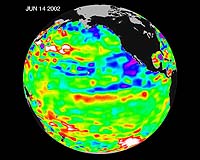| . |  |
. |
Manila (AFP) Sept 27, 2009 Seen from a military helicopter flying above the sprawling city, Manila was on Sunday covered by a sea of brown with islands of desperate people clinging to corrugated rooftops. One man, wearing only shorts and sandals, held up a piece of paper appealing for help with the words "food" and "water" scrawled on it. Elsewhere, residents who could not wait to be rescued waded through the water, carrying their children and anything else they could manage on their shoulders or heads. Two men converted a car roof top into a makeshift raft, and hauled themselves by rope across what was once a road but now a river. Elsewhere, dog and chicken carcasses floated in the water as rescuers in rubber boats struggled to navigate around mountains of debris. The devastation extended across vast areas of Manila after the heaviest rain in more than 40 years sent torrents of water up to six metres (20 feet) high streaming across the city on Saturday. The storm, which destroyed both shanty towns and upmarket suburbs, left at least 73 people dead and displaced more than 330,000, according to the government. Banking executive Rachelle Solis was still in shock on Sunday after she and her two children, aged six and eight, were almost swept away. Solis, 35, had taken the children to a daycare centre near the family home in a river-side northern Manila suburb. In a matter of minutes the water rose by about a metre and she decided to fetch her children. Once there, Solis was forced to take her children across the torrent of water to reach higher ground. Their only way across was via a rope someone had set up above the waters across the road. "We had no choice but to brave the flood. We couldn't wait for rescuers," Solis told AFP. "We thought we were going to die. My children kept crying. The current was so strong and we were nearly swept away... there was debris smashing into our bodies. I kept thinking this couldn't happen to me, not in Manila." Meanwhile, rescuers pushed on with efforts to reach those who remained stranded. President Gloria Arroyo had ordered all rescue work to be completed by nightfall on Sunday, but as daylight faded many areas of the city remained under water and countless people were left to fend for themselves. "Rescuers are not reaching the people inside the deeper areas," said Michael Ignas, 37, a tricycle driver in eastern Manila's Pasig city which was particularly hard hit. Ignas said he had survived the flooding by seeking refuge on the second floor of a building. As he spoke, the water remained neck-deep in nearby areas. For Red Cross volunteer Dave Barnuevo, the rescue work was proving almost impossibly difficult. "I've never seen flooding this devastating in Manila," Barnuevo told AFP, as he led a small team of rescuers scouring Provident, a sprawling river-side community in Marikina city, east of Manila. "The water is taking a long time to go down. The water is muddy and thick, and we have had to push our rubber boats in neck-deep waters in some areas." In one section of the village, rescuers retrieved a dead boy covered in mud. They placed his body alongside those of two adults waiting to be claimed by relatives. Share This Article With Planet Earth
Related Links Bringing Order To A World Of Disasters When the Earth Quakes A world of storm and tempest
 El Nino shift could boost hurricanes, intensify drought: study
El Nino shift could boost hurricanes, intensify drought: studyParis (AFP) Sept 24, 2009 Global warming periodically shifts El Nino thousands of miles to the west, potentially intensifying Asian droughts and weakening its dampening effect on Atlantic hurricanes, reports a study published Thursday. Up to now, the tropical weather phenomenon, which strikes on average every four or five years, has generally occurred along a wide stretch of the equator in the eastern Pacific. ... read more |
|
| The content herein, unless otherwise known to be public domain, are Copyright 1995-2009 - SpaceDaily. AFP and UPI Wire Stories are copyright Agence France-Presse and United Press International. ESA Portal Reports are copyright European Space Agency. All NASA sourced material is public domain. Additional copyrights may apply in whole or part to other bona fide parties. Advertising does not imply endorsement,agreement or approval of any opinions, statements or information provided by SpaceDaily on any Web page published or hosted by SpaceDaily. Privacy Statement |